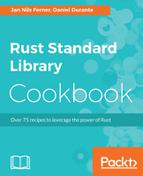- In the command line, jump one folder up with cd .. so you're not in chapter-one anymore. In the next chapters, we are going to assume that you always started with this step.
-
Create a Rust project to work on during this chapter with cargo new chapter-two.
- Navigate into the newly-created chapter-two folder. For the rest of this chapter, we will assume that your command line is currently in this directory.
- Inside the folder src, create a new folder called bin.
- Delete the generated lib.rs file, as we are not creating a library.
- In the folder src/bin, create a file called vector.rs.
- Add the following code blocks to the file and run them with cargo run --bin vector:
1 fn main() {
2 // Create a vector with some elements
3 let fruits = vec!["apple", "tomato", "pear"];
4 // A vector cannot be directly printed
5 // But we can debug-print it
6 println!("fruits: {:?}", fruits);
7
8 // Create an empty vector and fill it
9 let mut fruits = Vec::new();
10 fruits.push("apple");
11 fruits.push("tomato");
12 fruits.push("pear");
13 println!("fruits: {:?}", fruits);
14
15 // Remove the last element
16 let last = fruits.pop();
17 if let Some(last) = last {
18 println!("Removed {} from {:?}", last, fruits);
19 }
20
21 // Insert an element into the middle of the vector
22 fruits.insert(1, "grape");
23 println!("fruits after insertion: {:?}", fruits);
24
25 // Swap two elements
26 fruits.swap(0, 1);
27 println!("fruits after swap: {:?}", fruits);
- This is how you can access single elements in a vector:
29 // Access the first and last elements
30 let first = fruits.first();
31 if let Some(first) = first {
32 println!("First fruit: {}", first);
33 }
34 let last = fruits.last();
35 if let Some(last) = last {
36 println!("Last fruit: {}", last);
37 }
38
39 // Access arbitrary elements
40 let second = fruits.get(1);
41 if let Some(second) = second {
42 println!("Second fruit: {}", second);
43 }
44 // Access arbitrary elements without bonds checking
45 let second = fruits[1];
46 println!("Second fruit: {}", second);
- The next few methods apply to the whole vector:
50 // Initialize the vector with a value
51 // Here, we fill our vector with five zeroes
52 let bunch_of_zeroes = vec![0; 5];
53 println!("bunch_of_zeroes: {:?}", bunch_of_zeroes);
54
55 // Remove some item and shift all that come after
56 // into place
57 let mut nums = vec![1, 2, 3, 4];
58 let second_num = nums.remove(1);
59 println!("Removed {} from {:?}", second_num, nums);
60
61 // Filter the vector in place
62 let mut names = vec!["Aaron", "Felicia", "Alex", "Daniel"];
63 // Only keep names starting with 'A'
64 names.retain(|name| name.starts_with('A'));
65 println!("Names starting with A: {:?}", names);
66
67 // Check if the vector contains an element
68 println!("Does 'names' contain "Alex"? {}",
names.contains(&"Alex"));
69
70
71
72 // Remove consecutive(!) duplicates
73 let mut nums = vec![1, 2, 2, 3, 4, 4, 4, 5];
74 nums.dedup();
75 println!("Deduped, pre-sorted nums: {:?}", nums);
76
77 // Be careful if your data is not sorted!
78 let mut nums = vec![2, 1, 4, 2, 3, 5, 1, 2];
79 nums.dedup();
80 // Doens't print what you might expect
81 println!("Deduped, unsorted nums: {:?}", nums);
82
83 // Sort a vector
84 nums.sort();
85 println!("Manually sorted nums: {:?}", nums);
86 nums.dedup();
87 println!("Deduped, sorted nums: {:?}", nums);
88
89 // Reverse a vector
90 nums.reverse();
91 println!("nums after being reversed: {:?}", nums);
92
93 // Create a consuming iterator over a range
94 let mut alphabet = vec!['a', 'b', 'c'];
95 print!("The first two letters of the alphabet are: ");
96 for letter in alphabet.drain(..2) {
97 print!("{} ", letter);
98 }
99 println!();
100 // The drained elements are no longer in the vector
101 println!("alphabet after being drained: {:?}", alphabet);
102
103
104 // Check if a vector is empty
105 let mut fridge = vec!["Beer", "Leftovers", "Mayonaise"];
106 println!("Is the fridge empty {}", fridge.is_empty());
107 // Remove all elements
108 fridge.clear();
109 println!("Is the fridge now empty? {}", fridge.is_empty());
- We can split a vector into two and combine them again:
111 // Split a vector into two pieces
112 let mut colors = vec!["red", "green", "blue", "yellow"];
113 println!("colors before splitting: {:?}", colors);
114 let half = colors.len() / 2;
115 let mut second_half = colors.split_off(half);
116 println!("colors after splitting: {:?}", colors);
117 println!("second_half: {:?}", second_half);
118
119 // Put two vectors together
120 colors.append(&mut second_half);
121 println!("colors after appending: {:?}", colors);
122 // This empties the second vector
123 println!("second_half after appending: {:?}", second_half);
- You might remember the splice method from JavaScript:
127 let mut stuff = vec!["1", "2", "3", "4", "5", "6"];
128 println!("Original stuff: {:?}", stuff);
129 let stuff_to_insert = vec!["a", "b", "c"];
130 let removed_stuff: Vec<_> = stuff.splice(1..4,
stuff_to_insert).collect();
131 println!("Spliced stuff: {:?}", stuff);
132 println!("Removed stuff: {:?}", removed_stuff);
- If you are working with very big datasets, you can optimize the performance of your vector:
136 // Initialize the vector with a certain capacity
137 let mut large_vec: Vec<i32> = Vec::with_capacity(1_000_000);
138 println!("large_vec after creation:");
139 println!("len: {}", large_vec.len());
140 println!("capacity: {}", large_vec.capacity());
141
142 // Shrink the vector as close as possible to its length
143 large_vec.shrink_to_fit();
144 println!("large_vec after shrinking:");
145 println!("len: {}", large_vec.len());
146 println!("capacity: {}", large_vec.capacity());
147
148 // Remove some item, replacing it with the last
149 let mut nums = vec![1, 2, 3, 4];
150 let second_num = nums.swap_remove(1);
151 // This changes the order, but works in O(1)
152 println!("Removed {} from {:?}", second_num, nums);
153 }
